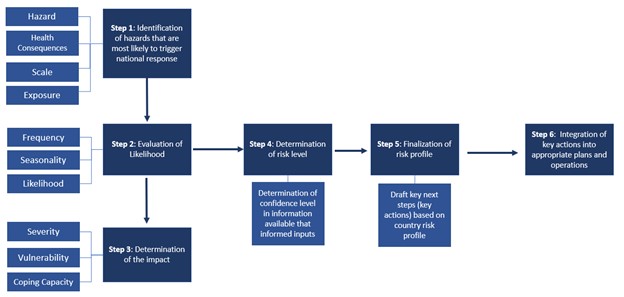Bhutan has been confronted with various disasters and emergencies, resulting in significant short- and long-term adverse effects on health at the individual, community, system, and national levels. The unprecedented COVID-19 pandemic served as a sobering reminder of the devastating impact infectious diseases can inflict. Despite substantial progress in fortifying health security systems worldwide, the pandemic has underscored our vulnerability to severe health emergencies. Presently, the world faces new challenges with emerging and re-emerging infectious diseases of zoonotic origin and geo-climatological hazards accelerated by climate change in addition to increasing health risks due to food safety, and chemical and radio-nuclear hazards.
In this context, one-health leaders in Bhutan have acknowledged the significance of risk profiling to guide emergency preparedness and response planning, as well as the prioritization of key actions for enhancing health security. The Strategic Toolkit for Assessing Risks provides a comprehensive set of tools that facilitate the swift and evidence-based evaluation of multi-hazard public health risks. This evaluation aligns with strengthening the core capacities required for compliance with the International Health Regulations (2005) and the goals of the Sendai Framework for Disaster Risk Reduction (2015-2030).
A 3-day workshop was organized in Paro, Bhutan from October 24 to 26, 2023 to complete this national risk assessment. The workshop facilitated the convergence of experts representing diverse sectors, encompassing both health and non-health disciplines, including national government officials, policymakers, technical experts, and academia. The eleven key government and departmental stakeholders, such as the Bhutan Food and Drug Regulatory Authority, National Medical Services, Department of Geology and Mines, Faculty of Nursing, Department of Local Governance and Disaster Management, Ministry of Agriculture and Livestock, National Centre for Hydrology and Meteorology (NCHM), Desuup (volunteers for disaster response), and the Department of Public Health etc., actively engaged in the workshop. Collaborating with partners such as the World Health Organization, the workshop's primary objective was to aid Bhutan in evaluating and determining public health risks associated with identified and anticipated hazards in the country.
The national facilitators diligently carried out essential technical and operational preparations in advance of the workshop. They meticulously collected all necessary primary and secondary data, complemented by assessments, evaluations, and monitoring under the IHR; meteorological profile descriptions; and other pertinent country-specific information. Throughout the workshop, subject matter experts from various technical domains made significant contributions, offering recommendations for appropriate measures to prevent, prepare for, respond to, and recover from emergencies and disasters. The workshop encompassed several key phases, which included: (1) hazard identification, (2) likelihood assessment, (3) impact evaluation, (4) risk level determination, and (5) the formulation of a risk profile—the final step involved identifying actionable steps and outlining the subsequent measures for multi-hazard risk management.

Through the process of risk profiling, various hazards, such as earthquakes, glacial lake outburst floods (GLOFs), forest/wildfires, floods, landslides, dengue, avian influenza, and more, were identified as having a high level of risk. The workshop yielded important results, including the risk matrix, a seasonal risk calendar, and key actions and next steps: these actions and subsequent measures involved identifying prevention, preparedness, and mitigation strategies for each hazard.
The outcomes and recommendations of STAR in combination with the outputs of other tools of the IHR Monitoring and Evaluation Framework such as the State Party Annual Report (SPAR), Joint External Evaluation (JEE), Intra- and After- Action Reviews (I/A-AR) and Simulation Exercises (SimEx) would drive robust risk-informed planning and implementation of priority actions covered in the national multi-hazard disaster management plan, national health emergency operational response plan, contingency plan and business continuity plan; and the National Action Plan for Health Security.
